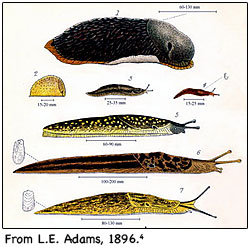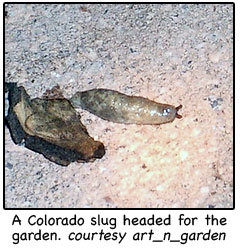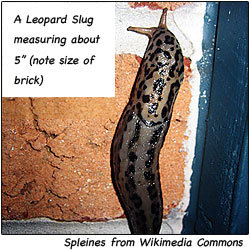





On an early morning stroll through the garden, sipping a mug of steaming coffee and inhaling the fresh dewy air, one comes upon a new begonia bloom with most of the petals chewed off. What a way to start the day! One or two slugs in a flower bed can wreak havoc, so prepare yourself for the onslaught of this night visitor.
This article was originally published on March 24th, 2008. While we welcome your comments, be aware that the author might not be available immediately to answer your questions.
These "snails without shells" have been around for centuries and, according to horticultural references from the late nineteenth century, have plagued mankind's gardens worldwide, especially in areas of high humidity.1 Slug damage not only affects the aesthetics of the garden, but the holes in (or defoliation of) a plant or fruit also provide a gateway for disease, not to mention relegating the specimen to an "un-saleable condition." The bad news is that "land slugs" - those we battle in our gardens - are hermaphrodites (having both female and male reproductive organs). Yes, every slug you see (or not) lays eggs!
Okay, enough about the history and love-life of these pests. What can you do about them?

The first and best control method consists of reducing the conditions for favorable habitat. Moist, cool, protected sites will attract slugs seeking shelter during the day and conditions in which to lay their eggs. Look at your gardens and determine ways to open them up to more sun or warm air. Over-mulching can provide perfect conditions for slug residence, so be sure mulch is 2 inches or less; keep the mulch material away from plant stems and trunks - an excellent hiding place with easy access to food. Remove dead or dying leaves from large-leaved plants such as Hosta or Caladium; this decaying material left in the garden provides yet another place to hide.
Next, adjust your watering schedule. Do not water in the evening, as the moisture will stay through the night, offering perfect dining conditions for these nocturnal creatures. (Additionally, watering at night provides perfect conditions for mildew and other humidity-related diseases.) Studies have indicated that watering only in the morning can reduce slug damage by up to 80%.2
Okay, the exposure and water conditions have been adjusted. What else can you do?
Traps
Methods for trapping slugs have been around since forever. Trapping is time and labor intensive, but effective (if you have the time and don't mind the work). Simply place the traps in cool moist areas, then collect the slugs in the morning and destroy them. Commercial traps are available, but homemade traps are simple and no-cost. Good trap materials include:

What About Commercial Slug Bait?
As responsible gardeners, we must always seek ways to control garden pests without harming our environment. In decades past, chemical control was utilized without too much thought to future consequences. Today's agricultural and horticultural communities are learning new methods to ensure a healthy planet for future generations. Commercial products for slug control still include a few that contain metaldehyde (which is toxic to pets and wildlife), but there are several safe "baits" which are effective for controlling slug damage; look for the ingredient "iron phosphate."
Slug baits are only effective if ingested. University of Oregon Extension recommends spreading bait at planting time, or just before seedlings sprout. OSU entomologist Glenn Fisher says, "When plants are just about to germinate, your slug bait is the only food on the soil surface and [slugs will] be more likely to go for it." Slugs are not likely to come down off mature flowers and vegetables to eat bait on the ground. With baits, "Even when good control is achieved, only about 60 percent of a given slug population is destroyed."3
Use any or all of the methods mentioned in this article, but first and foremost, keep your gardens clear of debris and hiding places, and be diligent about watching for early signs of slug damage.
For more than you ever wanted to know about slugs, visit these links:
Thanks to DG'er Art_n_Garden for some of the photos of these critters!
Copyright © www.100flowers.win Botanic Garden All Rights Reserved